 |
|

|
 |
TABLE of CONTENTS
 |
Conference explores latest innovations in transportation |
By Rich Kemp
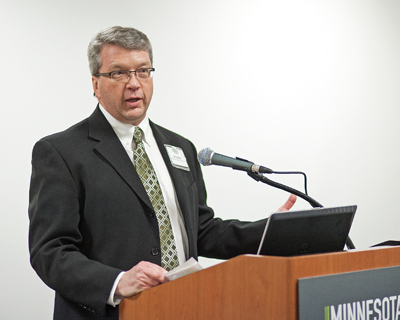
Jon Huseby, district engineer in District 8, spoke at the Transportation Conference about the MnDOT study designed to better understand shippers’ and carriers’ priorities and challenges with the transportation system. Photo by David Gonzalez |
More than 1,300 transportation industry professionals from across Minnesota attended the 2014 Transportation Conference in Bloomington March 4-6. It was the first time in 12 years that partners in transportation got together in this forum to learn, collaborate and share ideas.
“The conference was a huge success,” said Brad Hamilton, Consultant Services and conference planning committee member. “The responses during and after the event were overwhelmingly positive from attendees.”
The conference opened with remarks from Commissioner Charlie Zelle and Derrell Turner, Minnesota division administrator for the Federal Highway Administration. Speaking during the lunchon on the opening day were Bud Wright, American Association of State Highway and Transportation Officials executive director, and Doug Stang, 3M’s Office of Government Affairs. They discussed the importance of investing in transportation infrastructure and finding ways to maintain and upgrade the transportation systems so that companies like 3M can get their goods to market.
The conference included 41 breakout sessions, many of them moderated by MnDOT staff or having MnDOT presenters on the discussion panel. These sessions included topics such as:
- Cultivating a partnership in project development
- New technologies in surveying and mapping
- Pavement innovations and life-cycle costs
- Making the most of managed lanes
In addition, general sessions covered such topics as “How the Transportation System Supports Economic Competitiveness,” “When Generations Connect,” “Maximizing Choice and Efficiency through a Multimodal Transportation Network” and “Why Future Trends in Transportation Demand Unlearning.”
Presentation materials are posted on the Minnesota Transportation Conference website.
“Getting the Minnesota transportation community 'under one roof' was the cornerstone of this conference,” said Sue Mulvihill, deputy commissioner and chief engineer. “Sharing information and learning from peers and colleagues enhances our financial effectiveness as an agency by the relationships we build and the innovative technical knowledge we gain.”
Planning for next year’s conference has already started. Details will be posted on the conference website as they become available.
|
 |
|

|
 |
TABLE of CONTENTS
 |
Agency recommends dozens of outdated statutes be repealed in 2014 legislative session |
By Mary McFarland Brooks
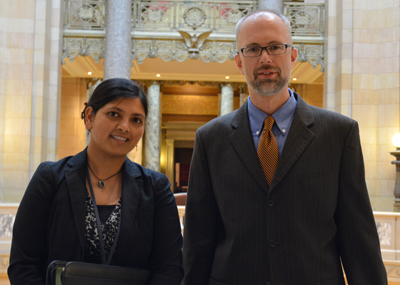
Shalini Chandra, legislative assistant on mobility from the Bridge Office, and Erik Rudeen, state legislative liaison, prepare for a Senate transportation hearing at the State Capitol during the 2014 Legislative Session. Photo by Rich Kemp |
The 2014 session of the 88th Minnesota Legislature convened on Feb. 25 as legislators from around the state gathered for what the governor is calling the "Unsession," which is scheduled to run for 13 weeks.
As part of the "Unsession," Gov. Dayton asked all state agencies to thoroughly review state laws and recommend any that could be repealed. MnDOT recommends deleting dozens of outdated and obsolete provisions, totaling almost 40 pages of statutes.
In addition, the department’s housekeeping bill includes provisions related to trunk highway turnbacks in Mankato and Brainerd, conforms state law on agricultural vehicles to federal law and updates statutes regarding turning movements at reduced conflict intersections. Other MnDOT initiatives extend the life of the Non-Motorized Transportation Advisory Committee by four years, clarify responsibilities for actions after township bridge inspections, update contracting laws and allow internal billing for products and services.
The 2014 legislative session does not include a transportation package in the supplemental budget. However, this session includes the following transportation items, which contain a few highway-related bills and other special revenue fund items:
Operations and maintenance investments
A $5 million trunk highway base increase in 2014 to accelerate the replacement of snowplow equipment from a 20-year average to 14 years. A $16 million one-time trunk highway appropriation in 2015 is also recommended for snow and ice support equipment, LED lighting on trunk highways, enhanced patching methods, changeable message signs, detection devices, and enhanced project management practices.
Highway 14 turnback settlement
Upgrading a section of Highway 14 requiring appropriation of $14 million before turning it over to Steele and Waseca counties is recommended. An additional $21 million from the current county state aid appropriation will be used to fund this project.
Aeronautics Appropriation
Allocating $4 million from the state airports fund to provide the local match to federal grants, and to fund pavement maintenance and other improvement to the states 135 airports is recommended.
Stillwater Lift Bridge endowment
Transferring up to $6 million from the current trunk highway appropriation for State Roads to a special revenue account for the operation and maintenance of the Stillwater Lift Bridge is recommended. This funding will establish an endowment, and only interest earnings will be spent. This maintenance fund was part of the agreement to build the St. Croix River Crossing. The maintenance costs will be shared with Wisconsin.
Products and services billing
Facilitating the legislative requirement for MnDOT to adopt a products and services orientation to its biennial budget is recommended by allowing the agency to allocate central services to the districts and programs that consume them.
Work Zone Safety Act
Another transportation bill, which is winding its way through the legislature, is the Work Zone Safety Act. This bill modifies provisions governing work zones to:
- Prohibit cell phone use in work zones when workers are present
- Set a $300 fine amount for some traffic violations in work zones
- Allocate fine revenue to a new work zone safety account
- Appropriate account funds for work zone safety activities
- Permit stopping and citing drivers or owners of vehicles used in violation of traffic flagger directions
- Modifies work zone speed limit provisions
For more information on the bills:
|
 |
|

|
 |
TABLE of CONTENTS
 |
Standing corn rows reduce winter’s work |
|
By Sue Roe
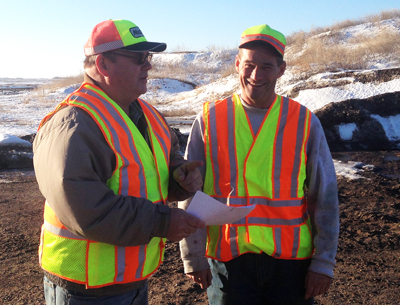
Fran Bigaouette, left, operations supervisor, and Gene Munsterman, District 7 snowplow operator, know roads in the southwestern part of the state can get hazardous when snow drifts across and closes roads. The standing corn row program helps MnDOT open roads sooner by not having to bring in the extra equipment to push back a snow bank. Munsterman was instrumental in getting new landowners to participate in the program this winter. Photo by John Traxler |
Last August, snowplow driver Gene Munsterman was probably one of the few people in the state thinking about snow. A 15-year snowplow driver from District 7, Munsterman knows how bad the roads can get in southwestern Minnesota when winter winds whip across the prairie. He knows which roads along his route frequently close because of blowing snow. He also knows about MnDOT’s standing corn rows program that keeps snow from drifting onto the roads.
The program started about 15 years ago and today there are 17 sites with more than six miles of standing corn rows, mostly in southwestern and central Minnesota. Other standing corn rows sites are in District 4 and District 6. The standing corn rows break the wind’s force, causing the snow to collect around the corn rows instead of drifting onto roads. The rows improve visibility and road surface conditions and lower costs of road maintenance.
Munsterman decided to talk to farmers before the harvest about leaving at least six rows of corn standing, so he studied plat books to find landowners’ names and started knocking on doors.
“I’m not much of a salesman,” he said. “A lot of farmers know it’s bad out there on their roads. Some have lived there all their lives.”
Fran Bigaouette, District 7 operations supervisor, agrees there can be big problems with drifting snow in the district. “It’s a windblown area. We’ve had stranded motorists out there before,” he said.
“Gene’s done a lot of work for this program,” he added. “He called on farmers at night and on weekends too. He saw the need for standing corn rows and made it happen. Gene is a farmer, too, so that helps establish relationships with other farmers.”
Of those 17 sites, Munsterman is responsible for getting five of them, including the three new farmers he signed up last August.
“Getting new ones to sign up is tough. I try to point out the positives and tell them about how MnDOT reimburses them for their inconvenience. It’s a good program. It works,” he said.
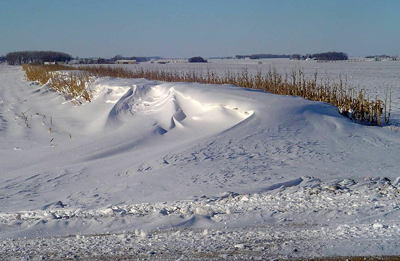
Standing corn rows hold back snow from drifting onto a roadway in southwestern Minnesota. When drifts close a road, MnDOT often brings out larger equipment such as blowers and dozers to remove the snow. The standing corn row program lowers costs of road maintenance and improves driver visibility and road surface conditions. Photo by Gary Wyatt, University of Minnesota Extension |
One of the obstacles farmers see with the program is that the standing corn rows need to be picked by hand or they have to bring out their combines in the spring.
“They also have to till that strip and they worry about volunteer corn coming up in the spring,” Munsterman added.
Gary Wyatt, University of Minnesota extension educator in the Mankato regional office, got area FFA and 4-H clubs to pick the corn. In return, the farmers agreed to donate a portion of the harvest proceeds to the clubs. Munsterman even helped youth pick the corn once.
“This is a great example of the rural community coming together and making a difference during the winter driving season,” said Dan Gullickson, living snow fence coordinator.
The program returns $14 in savings for plowing, equipment use and labor for every dollar invested.
“We get the benefit of snow control and FFA and 4-H members made a big difference in reducing our costs and ultimately helping people get safely to their destinations,” Gullickson said.
Research shows that standing corn rows reduced the severity of injuries on curves by 40 percent, he added.
“Gene was a champion in reaching out to landowners. It takes time to contact farmers and he took the initiative to go out and knock on their doors,” Gullickson said. “He knew if we could leave corn standing, we can save money and time. That’s being a good steward of the environment and financial resources.” |
 |
|

|
 |
TABLE of CONTENTS
 |
New policy guides MnDOT’s interactions with state’s 11 tribal nations |
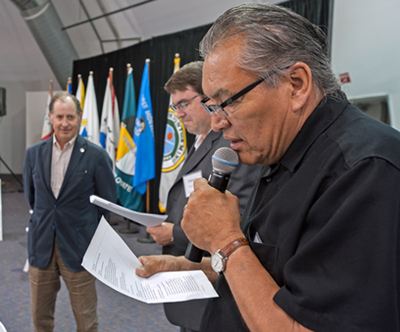
Commissioner Charlie Zelle (left) and Dr. Ed Minnema, assistant professor of Indian Studies, University of Minnesota – Duluth, listen to Art Owen, Prairie Island Indian Community spiritual leader, as he speaks to participants at the Tribal-State Relations Training last October. Photo by David Gonzalez |
Consultation, coordination and cooperation sum up the spirit of a new MnDOT policy that spells out the government-to-government relationship between the agency and each of the 11 Minnesota Tribal Nations.
“Our responsibility during all phases of our work is to consider the impact our efforts and decisions may have on tribal nations and individual American Indians, and work with the affected parties to reach mutually beneficial solutions,” said Commissioner Charlie Zelle, who has met with most of the tribal governments during the past couple of months to discuss their priority transportation issues.
The Minnesota Tribal Nations policy, which went into effect Feb. 25, stems from Gov. Mark Dayton’s Executive Order 13-10 last fall that required all executive branch agencies “to recognize the unique legal relationship between the State of Minnesota and the Minnesota Tribal Nations, respect the fundamental principles that establish and maintain this relationship, and accord Tribal Governments the same respect accorded to other governments.”
Besides developing and implementing tribal consultation policies, the executive order also requires state agencies to develop plans for training employees to effectively work government-to-government. The top executives from each state agency and tribal nation received the first government-to-government training in October 2013. The curriculum is being adapted for more widespread staff training during the next few months.
“The training requirements are an opportunity for all employees to gain a better legal and cultural understanding of the Minnesota Tribal Nations and, hopefully, lead to more effective and successful outcomes in the areas where our interests overlap,” said Linda Aitken, MnDOT’s tribal liaison, who noted that many state roads cross tribal lands.
That means, for example, engaging tribal nations early and addressing their interests throughout all stages of transportation projects—from planning to project development and scoping, to design to construction to operations and maintenance.
“We, as MnDOT staff, need to know and understand the unique legal relationship between the state of Minnesota and the Minnesota Tribal Nations,” Aitken said. “We need to always ask the question prior to undertaking any actions or policies, ‘Does this affect the tribes in any way?’ If so, we need to consult with them.”
“This is a breakthrough opportunity for MnDOT to improve the way we do business,” said Scott Peterson, Government Affairs director and Minnesota Tribal Nations policy owner. “We now have a better framework for improving our understanding of tribal perspectives and developing appropriate solutions when MnDOT work affects Indian people or tribal lands.
“Linda deserves a tremendous amount of credit for building strong relationships and trust with the tribal nations, and for her role in developing both the government-to-government policy and training,” he added.
Peterson also recognized the efforts of Nancy Melvin, MnDOT policy manager, for leading the policy work team and writing the new department policy, and doing so in a compressed period of time to meet the governor’s deadline of March 10, 2014.
“I feel privileged to have been a part of this important work and am proud of my colleagues for their thoughtful contributions to the policy,” Melvin said.
|
 |
|

|
 |
TABLE of CONTENTS
 |
Bridge Maintenance Academy expands bridge repair, maintenance skills |
|
By Sue Roe
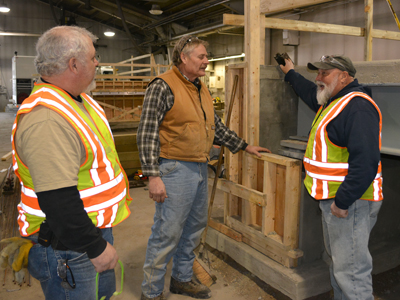
From left: Larry Waletzki, District 6 bridge supervisor; Doug Larson, consultant with Lake Superior Technical College-Duluth, and former MnDOT bridge supervisor; and Larry Cooper, engineering specialist senior, were among the instructors at the first Bridge Maintenance Academy III training in Skakopee in February. Twenty-five bridge maintenance workers took the training to learn how to maintain and repair bridges. Photo by Sue Roe |
Bridge maintenance workers need many skills to do their varied jobs. The first Bridge Maintenance Academy III training in Shakopee in February helped 25 of them acquire additional skills to repair and maintain bridges.
“All of these guys have less than five years of experience doing bridge maintenance activities, so this training gives them a good understanding of what’s expected of them in the field,” said Larry Cooper, engineering specialist senior. He led the training along with five district supervisors, two bridge transportation specialists and a former MnDOT bridge supervisor.
Most of the participants previously attended the Bridge Academy I and II training. In Bridge Academy I, they learned about bridge design, plan reading, mechanics and concrete mix design in a classroom setting. They also toured new state bridge construction sites and learned about bridge safety issues. In Bridge Academy II, participants formed and poured concrete slabs and abutments, learned how to remove and patch delaminated areas and tie rebar. They also had classroom presentations on formwork, steel and shotcrete, a process where compressed air forces concrete through a hose and nozzle.
“Bridge technicians take care of everything and anything,” Cooper said. “They get their feet wet here because they need to know the mechanics of a bridge and how everything they do has an impact on that structure.”
To start the week-long Bridge Academy III, employees formed and poured two 12-foot full depth bridge decks and then practiced maintenance procedures, including patching, jacking or lifting the bridge off the bearings, underpinning or strengthening the bridge foundation, and setting and repairing bearings, beams and railings.
District bridge supervisors and Lake Superior Technical College-Duluth, brought in tool trucks, concrete tools, a bridge jacking system and other equipment. The college also worked with the bridge supervisors to develop the curriculum.
Doug Larson, former bridge supervisor with 35 years of MnDOT experience and now a consultant with the college, said the training helps employees “stay way ahead of the game” as they repair and maintain the state’s 4,571 bridges.
“They learn bridge maintenance from the inside out,” said Larson. “I can see how much this class has learned from Bridge Academy II. They now have the knowledge to repair bridges because they’ve had the hands-on learning.”
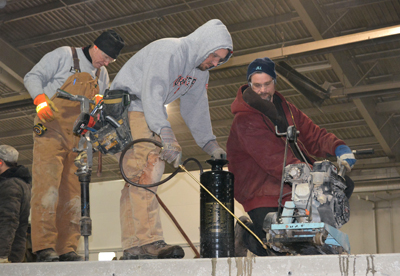
Dick Butler, left, Justin Bear, and Dan Malecha, all of the Metro District, practice bridge maintenance techniques during Bridge Maintenance Academy III in Shakopee. Butler is using a rivet buster to remove rivets from the bridge deck. Malecha is making a saw cut to patch the deck while Bear is applying water to keep the dust down. Photo by Sue Roe |
Justin Bear, Farmington, is a three-year bridge transportation generalist senior out of the Metro bridge office and also a union carpenter.
“I learned how to patch glands, so there are fewer washouts, and jack up a bridge so we can put bearings in place, and form decks,” he said. “These are the basic building blocks of our job. As a carpenter, I helped build bridges, but now I know how to maintain them.”
Bear’s carpentry skills are what MnDOT wants in its transportation generalists.
“We try to hire people with experience in carpentry, welding or a similar trade,” said Cooper, “but some don’t have that, so the Bridge Academy series gives them an opportunity to be introduced to the technology and different scenarios to expand their skills.”
Cooper said the academy training is more efficient than acquiring the skills on the job. “When you have new employees working with experienced people, we found that often the experienced people will take over and show the new people how to do something. In this training, they all learn by doing.”
He also said the training allows them to make mistakes in a controlled situation. Those same mistakes, if made in the field, would be critical.
“It’s a lot easier to teach someone in a situation without traffic racing past us. The training saves time and money because employees have a better understanding before they get to the field.”
The training also helps employees gain confidence to do their jobs.
“Bridge crews are a busy group and highly skilled,” said Cooper. “They need to be fully confident with doing their jobs. These men have a lot of responsibility resting on them to do their work correctly. It’s a dangerous job and they know that.”
The development of the Bridge Maintenance Academy series is in response to the high number of bridge maintenance retirements and promotions in 2011. MnDOT wanted to tap into the knowledge and expertise of the experienced bridge workers that remained and to develop a formalized way to transfer that knowledge efficiently. Bridge Maintenance Academy I was first offered in 2012 followed by Academy II in 2013 and Academy III this year.
Cooper said the Bridge Maintenance Academy series is successful because of everyone’s support to provide the best training possible to employees.
“MnDOT recognizes that an educated workforce makes people work more effectively, efficiently, safely and have more confidence in their abilities.” |
 |
|

|
 |
TABLE of CONTENTS
 |
iPads save crews time, money during field work |
By Bob Filipczak
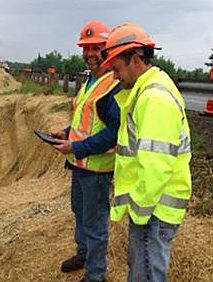
Duane Waller, District 1 transportation specialist, and Alan Price, District 1 transportation generalist, use an iPad in the field as part of a pilot program to improve and increase productivity and efficiency in the field. Photo by Dana Marrier |
When one of MnDOT's maintenance crews was spraying weeds, they discovered the speedometer on the truck was broken. That’s important, because to spray the herbicide effectively, you need to keep the truck within a specific range of miles per hour. So they did what anyone would do: they downloaded a speedometer app onto their iPad and used that to make sure they were going the right speed.
Of course, the only reason the crew could do that was because it was part of a pilot project—launched by MnDOT’s Connecting Employees through Technology team—that put iPads in the field. The iPads help workers access the right information quickly and communicate important information back to the truck stations without driving all the way back to the station every time. In this case, the team used the speedometer app for the rest of the day to finish the job, and it “saved us at least two hours and 40 miles of driving back in to get it fixed,” according to one crew member.
Here are some more comments from pilot participants:
“I was in the field and needed a purchase order for the bituminous plant and the truck could not be loaded until we had the PO. I was able to log in and get the PO number I needed within five minutes. It saved me a 20-mile round trip and from shutting down the crew of eight people.”
“I used my iPad for an incident where a contractor hit a drainage pipe not shown on their plan set. I sent photos and was able to confirm the pipe was on the Metro plan set. Immediate response allowed for immediate scheduling for repair, minimizing the time a hazard was left.”
“I was able to show my supervisor photos of an emergency drainage issue within minutes of taking the photos. Immediate understanding of the issue was invaluable in activating the correct emergency response. Hours were saved when minutes may have been critical.”
“I did not even carry a paper plan with me this year on my construction projects. I have the plans, provisions, spec. book, standard plates, contract administration manual, traffic control manual and many other documents loaded right on my iPad. I can search and find things much faster and email highlighted sections from wherever I am.”
Participants reported more than 100 situations highlighting time and cost savings or better communications with co-workers, partners and contractors.
The CETT team started the pilot program by researching the needs of workers in the field. Workers said they needed to improve intra-crew communication and information, get technology to access virtual meetings, and get training on the equipment. In summer 2013, 37 iPads were put into the hands of workers.
The CETT team said the iPads improved:
- Access to weather information
- Ability to send photos easily from the field
- Accessing email directly from the field (instead of driving back in the truck station)
- Calling up maps
- Ability to download reference manuals from the field
- Completion of administrative functions, such as timesheet approvals and purchasing
Maintenance and construction departments that have iPad users expect to see continued increased productivity, savings in gas, faster response times to incidents, and increased safety for employees and the traveling public, according to CETT's final report.
The report indicates that 43 percent of the pilot participants had never used a personal mobile tablet or smart phone and that 80 percent had never used an iPad. Now, some of those same users are the heaviest iPad users in the field, according to the report. |
 |
|

|
 |
TABLE of CONTENTS
 |
Providing better state services – a plain language approach |
By Sue Roe
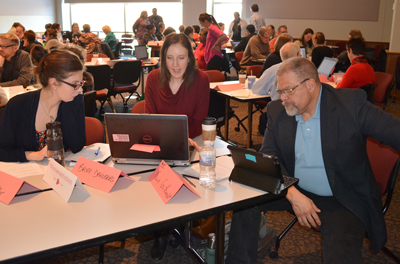
Participants in the governor’s plain writing workshop Feb. 14 include Cara Chandler, Metro District; Becky Dahlberg, Communications; and Kevin Gutknecht, Communications. Participants gained skills to write and edit using plain language principles and learned best practices to integrate plain language throughout the state. During the training, each agency revised one of its own documents using plain language. Photo by Sue Roe |
State government works better when the public understands communications provided to them the first time they read or hear them. That’s the message in Gov. Mark Dayton’s March 4 executive order directing agencies to use plain language in its documents, web pages and other communications with the public.
The order says that plain language reduces confusion, saves time and improves customer satisfaction. Plain language helps readers make fewer errors filling out forms. They call less often for explanations and they comply more accurately and quickly with requirements.
The governor’s initiative has two steps, according to Kevin Gutknecht, Communications director who is overseeing MnDOT’s plain language initiative. One is to help agency employees use plain language in documents such as web pages, letters, reports and emails. The second is to rewrite at least one document each month using plain language techniques.
“There’s no downside to using plain language. Clearly written documents increase agency efficiency and reduce the public’s need for clarification. These are positive steps we can all make happen,” he said.
Representatives from state agencies learned how to use plain language at a training Feb.14 organized by the governor’s office.
Natalie Conway, Department of Revenue trainer, said agency employees tend to overestimate their reader’s understanding by about 30 percent.
“When people don’t understand, they’re confused people. Plain language helps avoid customer frustration,” she said.
Plain language techniques include understanding who the reader is, planning and organizing content, and writing concisely and simply. Plain language principles include writing short sentences and paragraphs, using active voice, summarizing main points, avoiding unnecessary words, and formatting information with headings, lists and tables.
Plain language writing eliminates words such as shall, attempt, commence and demonstrate, and replaces them with must, try, start and show or prove. It also avoids bureaucratic and legal language and uses words commonly understood. Plain language encourages writers to write the way they speak.
For example, the sentence: “Copies of tax returns must be provided” can be written more concisely this way: “You must provide copies of your tax returns.”
The sentence: “These sections describe types of information that would satisfy the application requirements for a private pilot license” can be rewritten as: “These sections tell you how to meet the requirements for a private pilot certificate.”
For more information on plain language and for communications tools to make writing more clear, see MnDOT’s web site at http://ihub.dot.state.mn.us/plainlanguage. Additional information can be found on the federal government site at plainlanguage.gov. |
 |
|

|
 |
TABLE of CONTENTS
 |
Seeing is believing – MnDOT video showcases 2013 highlights |
|
The 2013 highlights video features several projects around the state. The four-minute production includes a blend of projects in the Minneapolis/St. Paul metropolitan area as well Greater Minnesota, including International Falls, Moorhead and St. Cloud. Feedback from MnDOT’s customers confirms that they value hearing and seeing stories about the work the agency’s doing for Minnesota.
Minnesota’s statewide multimodal system is featured throughout the video including segments about improvements to state highways, freight, aviation, bike and pedestrian facilities. It also details how transportation projects benefit taxpayers through efficiency, costs savings and reduced traveler impacts.
“A video is an effective tool that helps us to visually showcase the great work our agency is doing. I encourage employees to share this video with family and friends," said Karla Rains, Customer Relations director.
The video was created and produced by Stephany Osuji, Customer Relations, and Joel Wenz, Video Services, and includes:
• Commissioner Charlie Zelle’s statewide tour with town hall meetings discussing the need to invest in the future of transportation
• Hastings Bridge
replacement
• St. Croix Crossing Project
• Diverging diamond interchange
• Maintenance: Full closure on I-35W and I-94
• Moorhead bike and pedestrian upgrades
• MnDOT national awards for innovation: Mississippi River Bikeway, Hwy 169/I-494 Interchange project and Hwy 610 extension project
• Aeronautics and Aviation: Skywest expansion
• Regional Transportation Management Center's 10th Anniversary
• District 8 freight and manufacturers study
• Corridors of Commerce |
|
 |
|

|
|
| |
|



